Here we introduce some of the most
important acupuncture points. If you press it and feel very pain
on pressing it, it means that there is something wrong in your
body. Depending on which point it is, the prediction meaning is
also different. Some points suggest pain or problem in stomach;
others may predict something wrong in liver.
Another important concept is that, the pain
point does not only predict the structure problem in the body,
but also emotional trouble too. This is because the fact that
each meridian is associated to various kind of emotion too. For
example, if the heart has trouble, one may have a feeling of
over irritable to laugh; if the liver has trouble, one may feel
easy to get upset; if the spleen is in trouble, one may feel
worry; if the kidney is in trouble, one may feel sad; and if the
lung is in trouble, one tends to crying.
1.
Hegu point
He-gu point is located on hand, between the
first and the second finger (see Fig. 1). If you feel much pain
when you press this point, there will be several meanings:
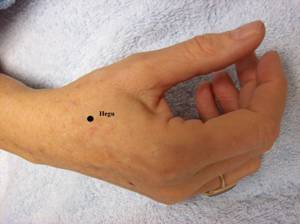
Fig.
1 (Hegu point)
(1). Local pain. It feels pain of course
when it is damaged on the thumb, wrist or surrounding tissues.
(2). Along meridian. If you feel pain on
this spot when pressing, it suggests that you may have trouble
on any part along the Shou Yangming meridian, from the outside
of the nail on the thumb up to the nose on the another side of
the face. Shou means hands in Chinese. Therefore if you have
pain on the front arm, elbow, top of the shoulder, front neck,
teeth, and nose, you may feel pain in this point. On the other
side, if you really feel pain on this spot, you can press or
massage on it, whichever ways you apply, could release pain on
the meridian pathway mentioned above.
Actually this point is responsible for any
trouble in the face and mouth.
(3). The name of this meridian in which the
Hegu point located is Large intestine. Therefore, if you have
any trouble, constipation or diarrhea, pain or intestine
obstruction, or stomach bloating, etc.
When you press this point to solve or
release pain. It is also good for the treatment any illness in
face, heat, eyes, nose, ear, throat, and fever.
2.
Zusanli point
Zusanli point is located on the outside of
the small leg, just under the knee (see Fig. 2).
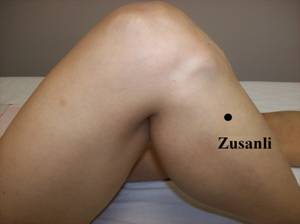 Fig. 2. Zusanli point
Fig. 2. Zusanli point
Similar to the Hegu point, any acupuncture
point has three functional meanings when pressed pain, local
significance, along meridian, and related to inside health
problem.
(1). Local pain. It you feel pain on this
spot when press, you may have pain or swelling on the knee or
its surrounding area.
(2). Along meridian. If you feel pain on
this point when press, it suggests health trouble on any part of
the body along the Zu Yangming meridian, from the second toe up
to the front of leg, front of stomach, front but alone the line
passing the nipple, to the neck, to the side of face, to the
inner eye and inner end of the eyebrow, and to the upper and
outside of front hair edge. Zu
means feet in Chinese. Any pain along this long meridian can be
found pain on this point.
(3). The name of this meridian in which the
Zusanli point located is Stomach. Therefore, if you have any
trouble in the belly area, you can try to press this point to
solve or release pain. Also, even if you have no pain on this
point, or you do not feel anything wrong in your body, pressing
on this point everyday is very good to maintain your health. It
works much better if you can use moxa to warm it up everyday.
Press most of the acupuncture points on
this Large intestine meridian helps to release illness on
digestive system, head and face, eye, nose, mouth, teeth, mind
aspect.
3.
Taichong
Taichong point is located on the back of
foot (see Fig. 3).
Taichong point belongs to Liver meridian.
If you feel pain on this point, it means:
(1). You may have pain on your feet, or
somewhere around the first and second toes, or on the ankle.
(2). You may have trouble along the liver
meridian pathway. This pathway goes from the first toe up to
ankle, to inner side of the leg, to the sexual organs, then into
stomach cavity and to the liver.
(3). Taichong point belongs to Liver
meridian, so any trouble in the liver may cause pain on this
point, hepatitis, or fat liver. Also, because the liver meridian
is much more associated to the emotional disorders, patients
with extreme stress are found pain on this spot so often.
Press most spots on the Liver meridian
helps to release illness on the liver, women system, front sex
part, as well as the illness alone the meridian per se.
 Fig. 3. Taichong point.
Fig. 3. Taichong point.
4.
Zulingti point
Zulingti point is localized on Gall bladder
meridian. It is also on the back of the foot, but on the small
toe side (Fig. 3). If you feel pain on this point when press it,
it means:
(1). You may have pain or damage on the
outside of foot, on the small toe, or outside of ankle.
(2). You may have pain or other trouble on
the body surface along the Gall bladder meridian pathway. Since
this meridian mostly goes on the side of the body, so in clinic,
when the pain is on the side of body, we consider the Gall
bladder meridian first. The Gall bladder meridian goes from the
small toe, up to the outside of legs, outside of stomach,
outside of neck and the outside of head, then finally ends at
out end of the eye (Fig. 4a, 4b, 4c).
If you also find a pain spot on the end
point of the meridian, the name of which is Tongziliao (the
starting point of the Gall bladder meridian), you should feel
much confidence that the trouble is on this meridian. Press on
Tongziliao point, you can release pain on the small toe (the end
point of the meridian). If you press on Zulingti, you can also
release the pain on the side of the head – it is good for the
treatment of migraine too.
(3). Zulingti belongs to Gall bladder
meridian. So any trouble in the gall bladder might cause pain in
this point when press. The trouble could be infection or gall
bladder stones. This is one of the important point we use to
stimulate expel of stone from the gall bladder.
Press most acupuncture points on the Gall
Bladder meridian helps to release illness about gall bladder,
side part of the body (such as migraine, side rib pain), eye,
ear, throat, emotion, fever, as well as the illness alone the
meridian.
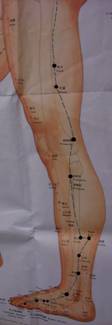 Fig. 4a.
Fig. 4a.
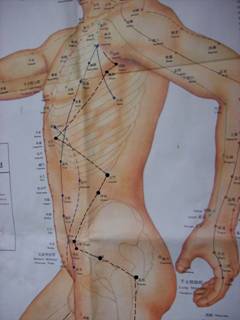 Fig.
4b.
Fig.
4b.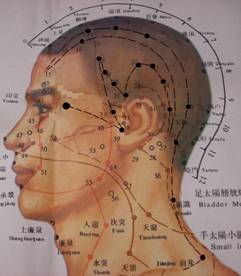 Fig. 4c.
Fig. 4c.
5.
Gongsun point
Gongsun point (Fig. 5) is located in the
Spleen meridian. It is in the inside of the foot. The Spleen
meridian (Fig. 5a) goes from the inside of the big toe, up and
along the inside of foot, the leg and comes into the stomach, to
the spleen.
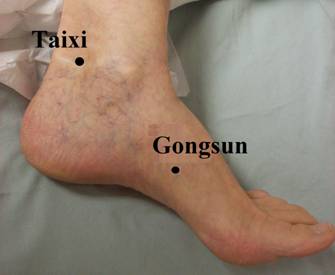 Fig. 5. |

Fig. 5a. |
If you feel pain on this point when press,
there may suggest:
(1). You have pain on or close to this
point: on the toe, or on the ankle.
(2). You may have pain alone the Spleen
meridian, such as on the inside of small leg, on the knee, or on
the groin.
(3). You may have some trouble in the sugar
and cholesterol metabolism, or is with overweight. For people
with allergic reaction, this point is also pain, since one of
the function of the Spleen system is to monitor the outside
stimulation. It works as sensor. Allergic reaction means that
the Spleen as organ or as the meridian is too sensitive, to
transport the signal to the immune defense system to react. This
is Chinese medicine concept.
If you also have pain in the Yinlingquan
point (Fig. 5b), there is much more chance that there are
something in the Spleen system (as organ or as meridian).
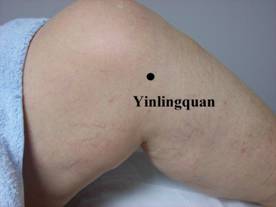 Fig. 5b.
Fig. 5b.
6.
Yongquan point
Yongquan point is located on the bottom of
the foot (Fig. 6a). It belongs to Kidney meridian. If you feel
pain when you press this point, it may mean:
(1). You have pain on the bottom or on the
back of the foot.
(2). You may have pain alone the pathway of
the Kidney meridian. Kidney meridian goes up to the back of the
ankle, up alone the inside of the leg into the stomach and then
into the bladder and kidney.
(3). You may have trouble that related to
the Kidney system in the body. Kidney system (the TCM concept)
contains the urinary function, reproductive function, bone,
teeth, ear (hearing ability), and brain functions too. If you
can feel pain on the Taixi point (behind the ankle), the chance
that you have trouble in the Kidney system is much higher.
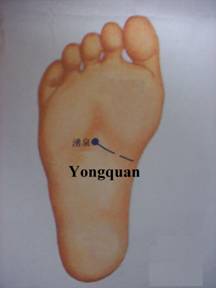
Fig. 6a |
 Fig. 6b. |
7.
Jinggu and/or Jinmen
Jinggu and Jinmen
point are on the out side of foot (Fig. 7a). They belong to
Urine bladder meridian. This meridian is one of the longest
meridians in the body. It starts from inside of the eye (Jingming
point, Fig. 7b), up to the inside end of the eyebrow, up to the
top of the head, down the neck, down the back (all beside and
alone the middle line of the body), then down on the back of the
leg, behind the ankle, and alone the out side of the foot.
If you feel pain on the Jinggu and
Jinmen
points, it means:
(1). You may have pain on feet around or
close to these two points.
(2). You may have pain on the body alone
the Urine bladder meridian, e.g. outside of foot, back of leg,
back of body, back of neck, top of head and front of head.
(3). You may have common cold. In TCM,
common cold means a illness-causing factor (we call them Fire,
Cold, Wetness, Wind, or others) affects the body in the surface
lever. The Urine bladder is the first meridian that will be
affected by the illness-causing factor. Therefore if you have
common cold, press the starting points of this meridian, the
point of Jingming and Zanzhu (Fig. 7b).
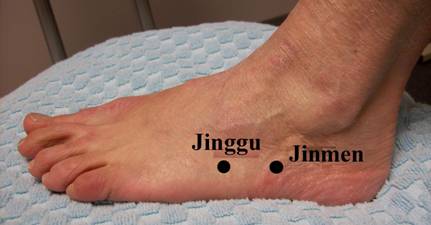 Fig. 7a.
Fig. 7a. 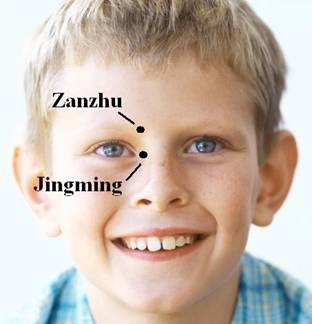
Fig.
7b. Starting point of Urine Meridian. Jingming and Zanzhu
points.
8.
Houxi and Wangu
These two points
belong to Small intestine meridian. They are located on the
outside of the hand (Fig. 8a).
If you feel pain
on either of the two points, when pressing on them, it may mean:
(1). You have
pain on the small finger, on the out line of the hand, on the
wrist.
(2). You may
have pain or some other trouble alone the pathway of this Small
intestine meridian. This meridian goes starting from the outside
of the nail of the small finger, up in between the fourth and
the fifth finger, to the out side of the hands, the wrist, arm
up to the back of the scapula, to the chess, then end at the
front of ear.
(3). You may
have pain or other trouble in the small intestine, diarrhea, or
poor digestion.
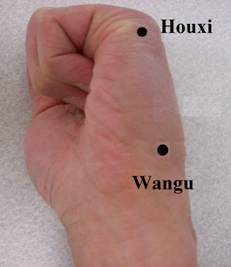 Fig. 8a
Fig. 8a
9.
Zhongzhe and Waiguan
These two points are on the back of hand
and arm (Fig. 9). They belong to Triple Jiao meridian. If you
feel pain on these two points when pressing, it may suggest:
(1). You have pain on the hand, wrist or
arm. If yes, press these two points may help to release pain
there.
(2). You may have pain or something wrong
on the pathway of this meridian. This meridian goes from the out
side of the ring finger, up to the back of hand, to the middle
back of the arm, middle back of shoulder top, to the side of
neck, beneath of ear, then around the ear on the back of the
ear, to the front of ear, then to the out end of eyebrow. For
ear ringing, deafness, migraine, the point of Zhongzhe is mostly
used. You can also press these two points for the problem that
occur alone the pathway of this meridian.
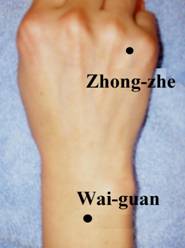 (Fig. 9a)
(Fig. 9a)
10.
Lieque point
Lieque and Kongzui belong to Lung meridian.
They are on the edge of the arm (Fig. 10). If you feel pain on
pressing these two points, it may mean:
(1). You have pain or some other trouble on
your wrist, hand, or front arm.
(2). You may have pain on your body
surface, alone the pathway this meridian goes. This meridian
goes from you lung, out of the front and out side of chest, into
arm, alone the arm to the wrist and to the thumb. Any troubles
that happens alone this pathway may make you feel pain on these
points.
(3). You have trouble in the inside organ
this meridian links: the lung. Leique is a very important point
for the treatment of common cold, cough, chest pain, short of
breath, asthma, sour throat. It is also very important in the
quit smoking program.
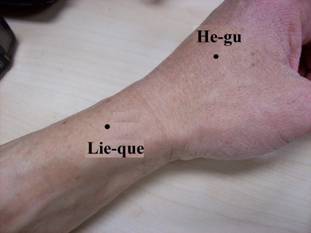 Fig. 10.
Fig. 10.
11.
Neiguan point.
Neiguan is a very important point that lies
on the Heart Shell meridian. This meridian goes from heart
(around heart), to the arm pit, down to the arm (inside), to
elbow, to the middle of the inside of front arm, to the inside
and middle of wrist and ends at the tip of middle finger.
If you feel pain on this spot when
pressing, it may mean:
(1). You have pain on and around this
point, or on the wrist or palm.
(2). You have trouble in the body surface
along the pathway of this meridian, e.g. the middle finger, the
palm, the inside of wrist, the arm, and the chest.
(3). You have some pain in chest, nausea,
dizziness, comma, or psychological illness, etc. If you have
nausea, such as during traveling, press this Neiguan point. It
may help you.
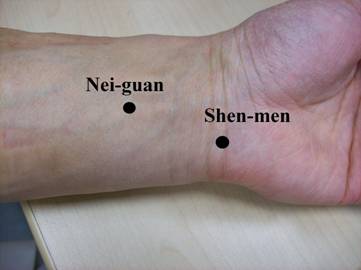 Fig. 11.
Fig. 11.
12.
Shenmen point.
Shenmen point (Fig. 11) is located on the
Heart meridian. Note that the Heart meridian is not the same as
the above Heart Shell meridian, though the Heart meridian also
starts from the heart and goes down to the arm, the hands
parallel to the Heart Shell meridian. However it ends at the end
of the small (the fifth) finger.
If you feel pain in this acupuncture point,
it may mean:
(1). You have pain in the hand or wrist
close to this point.
(2). You have pain in the body surface,
alone the pathway of the Heart meridian.
(3). You have pain in the heart (the
coronary heart disease), dry mouth, hot feeling in palm.
Hipnoterapi untuk penyakit juga tersedia bagi pasien yang membutuhkan.
Hubungi Accurate Health Center Medan untuk penanganannya.
"Accurate" Health Center Medan
Jl. Tilak No. 76 (Simpang Demak)
Telp. (061) 7322480
Medan
Website : http://www.accuratehealth.blogspot.com
Tidak ada komentar:
Posting Komentar